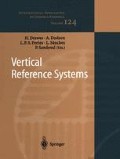Abstract
Generally, the values of the gravity are obtained on roads, and near rivers and valleys. This kind of distribution may produce irregular space data and lacking of data in large areas. Geoid heights are usually estimated in regular grids using spectral techniques. Numerous methods have been used for free air gravity anomalies interpolation. This paper reports an Artificial Neural Network (ANN) implementation for predicting free air gravity anomaly. The results were compared with both Kriging and Minimum Curvature. The ANN shows better results in the prediction.
Access this chapter
Tax calculation will be finalised at checkout
Purchases are for personal use only
Preview
Unable to display preview. Download preview PDF.
References
Bureau. Gravimetric International (BGI) http://siriusci.cst.cnes.fr:81 10
Cressie, N (1993). Statistics for Spatial Data. ISU. New York, USA.
Gose, E. et.al (1996). Pattern Recognition and Image
Analysis. Prentice Hall PTR. New Jersey, USA. Heiskanen, W., and Moritz, H (1985). Geodesia Ffsica. Instituto Geografico Nacional, Madrid, Spain.
Li, Y., and Bridgwater, J (1999). Prediction of Extrusion Pressure Using an Artificial Neural Network. Powder Technology 108: 65–73.
Loesch, C., and Sari, S (1996). Redes Neurais Artificias.
Fundamentos e Modelos. FURB, Blumenau, Brazil. Smith, W., and Wessel, P (1990). Gridding with Continuous Curvature Splines in Tension. Geophysics 55(3):293–305. Subcommittee Gravity and Geoid for South America.
Watson, D (1992). Contouring: A Guide to the Analysis and Display of Spatial Data. Pergamon, London, UK.
Torge, W (1989). Gravimetry. Walter De Gruyter. New York, EUA.
Author information
Authors and Affiliations
Editor information
Editors and Affiliations
Rights and permissions
Copyright information
© 2002 Springer-Verlag Berlin Heidelberg
About this paper
Cite this paper
Tierra, A.R., de Freitas, S.R.C. (2002). Predicting Free-Air Gravity Anomaly Using Artificial Neural Network. In: Drewes, H., Dodson, A.H., Fortes, L.P.S., Sánchez, L., Sandoval, P. (eds) Vertical Reference Systems. International Association of Geodesy Symposia, vol 124. Springer, Berlin, Heidelberg. https://doi.org/10.1007/978-3-662-04683-8_41
Download citation
DOI: https://doi.org/10.1007/978-3-662-04683-8_41
Publisher Name: Springer, Berlin, Heidelberg
Print ISBN: 978-3-642-07701-2
Online ISBN: 978-3-662-04683-8
eBook Packages: Springer Book Archive

